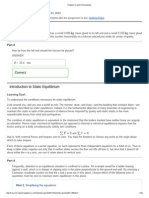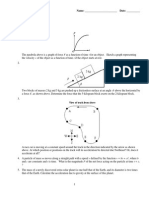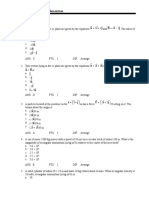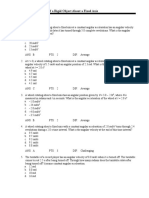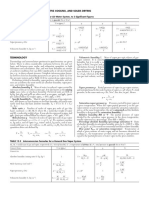Chapter 02 Homework
Uploaded by
Fatboy91Chapter 02 Homework
Uploaded by
Fatboy913/3/2014
Chapter 2 Homework
Chapter 2 Homework
Due: 10:00pm on Friday, February 7, 2014
You will receive no credit for items you complete after the assignment is due. Grading Policy
Exercise 2.3
You normally drive on the freeway between San Diego and Los Angeles at an average speed of 105 km/h, and the trip
takes 2 h and 20 min. On a Friday afternoon, however, heavy traffic slows you down and you drive the same distance
at an average speed of only 69.0km/h .
Part A
How much longer does the trip take?
ANSWER:
t
= 73.0
min
Correct
Exercise 2.7
A car is stopped at a traffic light. It then travels along a straight road so that its distance from the light is given by
2
3
2
3
x(t) = bt ct , where b = 2.70m/s and c = 0.120m/s .
Part A
Calculate the average velocity of the car for the time interval t= 0 to t= 10.0 s.
ANSWER:
v av
= 15.0
m/s
Correct
Part B
Calculate the instantaneous velocity of the car at t=0.
ANSWER:
v
= 0
m/s
Correct
http://session.masteringphysics.com/myct/assignmentPrintView?assignmentID=2752844
1/18
3/3/2014
Chapter 2 Homework
Part C
Calculate the instantaneous velocity of the car at t=5.00 s.
ANSWER:
v
= 18.0
m/s
Correct
Part D
Calculate the instantaneous velocity of the car at t=10.0 s.
ANSWER:
v
= 18.0
m/s
Correct
Part E
How long after starting from rest is the car again at rest?
ANSWER:
t
= 15.0
Correct
Exercise 2.10
A physics professor leaves her house and walks along the sidewalk toward campus. After 5 minutes it starts to rain and
she returns home. Her distance from her house as a function of time is shown in the figure.
http://session.masteringphysics.com/myct/assignmentPrintView?assignmentID=2752844
2/18
3/3/2014
Chapter 2 Homework
Part A
At which of the labeled points is her velocity zero?
ANSWER:
I
II
III
IV
V
Correct
Part B
At which of the labeled points is her velocity constant and positive?
ANSWER:
I
II
III
IV
V
Correct
http://session.masteringphysics.com/myct/assignmentPrintView?assignmentID=2752844
3/18
3/3/2014
Chapter 2 Homework
Part C
At which of the labeled points is her velocity constant and negative?
ANSWER:
I
II
III
IV
V
Correct
Part D
At which of the labeled points is her velocity increasing in magnitude?
ANSWER:
I
II
III
IV
V
Correct
Part E
At which of the labeled points is her velocity decreasing in magnitude?
ANSWER:
I
II
III
IV
V
Correct
http://session.masteringphysics.com/myct/assignmentPrintView?assignmentID=2752844
4/18
3/3/2014
Chapter 2 Homework
Direction of Velocity and Acceleration Vector Quantities Conceptual Question
For each of the motions described below, determine the algebraic sign (+, , or 0) of the velocity and acceleration of
the object at the time specified. For all of the motions, the positive y axis is upward.
Part A
An elevator is moving downward when someone presses the emergency stop button. The elevator comes to rest a
short time later. Give the signs for the velocity and the acceleration of the elevator after the button has been pressed
but before the elevator has stopped.
Enter the correct sign for the elevator's velocity and the correct sign for the elevator's acceleration,
separated by a comma. For example, if you think that the velocity is positive and the acceleration is
negative, then you would enter +,-. If you think that both are zero, then you would enter 0,0.
Hint 1. Algebraic sign of velocity
The algebraic sign of velocity is determined solely by comparing the direction in which the object is moving
with the direction that is defined to be positive. In this example, upward is defined to be positive. Therefore,
any object moving upward, whether speeding up, slowing down, or traveling at constant speed, has positive
velocity.
Hint 2. Algebraic sign of acceleration
The algebraic sign of acceleration is more difficult to determine than the algebraic sign of velocity. The
acceleration of an object points in the same direction as the change in the velocity of an object. If an object
is speeding up, the change in the velocity points in the same direction as the velocity:
If an object is slowing down, the change in velocity points in the opposite direction to that of the velocity:
http://session.masteringphysics.com/myct/assignmentPrintView?assignmentID=2752844
5/18
3/3/2014
Chapter 2 Homework
Once you know the direction of the acceleration, you can determine its sign by comparing it to the defined
positive direction, in this case, upward.
ANSWER:
-,+
Correct
Part B
A child throws a baseball directly upward. What are the signs of the velocity and acceleration of the ball
immediately after the ball leaves the child's hand?
Enter the correct sign for the baseball's velocity and the correct sign for the baseball's acceleration,
separated by a comma. For example, if you think that the velocity is positive and the acceleration is
negative, then you would enter +,-. If you think that both are zero, then you would enter 0,0.
Hint 1. Algebraic sign of velocity
The algebraic sign of velocity is determined solely by comparing the direction in which the object is moving
with the direction that is defined to be positive. In this example, upward is defined to be positive. Therefore,
any object moving upward, whether speeding up, slowing down, or traveling at constant speed, has positive
velocity.
Hint 2. Algebraic sign of acceleration
The algebraic sign of acceleration is more difficult to determine than the algebraic sign of velocity. The
acceleration of an object points in the same direction as the change in the velocity of an object. If an object
is speeding up, the change in the velocity points in the same direction as the velocity:
http://session.masteringphysics.com/myct/assignmentPrintView?assignmentID=2752844
6/18
3/3/2014
Chapter 2 Homework
If an object is slowing down, the change in velocity points in the opposite direction to that of the velocity:
Once you know the direction of the acceleration, you can determine its sign by comparing it to the defined
positive direction, in this case, upward.
ANSWER:
+,-
Correct
Part C
A child throws a baseball directly upward. What are the signs of the velocity and acceleration of the ball at the very
top of the ball's motion (i.e., the point of maximum height)?
Enter the correct sign for the baseball's velocity and the correct sign for the baseball's acceleration,
separated by a comma. For example, if you think that the velocity is positive and the acceleration is
negative, then you would enter +,-. If you think that both are zero, then you would enter 0,0.
http://session.masteringphysics.com/myct/assignmentPrintView?assignmentID=2752844
7/18
3/3/2014
Chapter 2 Homework
Hint 1. Algebraic sign of velocity
The algebraic sign of velocity is determined solely by comparing the direction in which the object is moving
with the direction that is defined to be positive. In this example, upward is defined to be positive. Therefore,
any object moving upward, whether speeding up, slowing down, or traveling at constant speed, has positive
velocity.
Hint 2. Algebraic sign of acceleration
The algebraic sign of acceleration is more difficult to determine than the algebraic sign of velocity. The
acceleration of an object points in the same direction as the change in the velocity of an object. If an object
is speeding up, the change in the velocity points in the same direction as the velocity:
If an object is slowing down, the change in velocity points in the opposite direction as the velocity:
Once you know the direction of the acceleration, you can determine its sign by comparing it to the defined
positive direction, in this case, upward.
ANSWER:
0,-
http://session.masteringphysics.com/myct/assignmentPrintView?assignmentID=2752844
8/18
3/3/2014
Chapter 2 Homework
Correct
Exercise 2.14
A race car starts from rest and travels east along a straight and level track. For the first 5.0 s of the car's motion, the
eastward component of the car's velocity is given by x (t) = (0.900 m/s3 )t2 .
Part A
What is the acceleration of the car when x = 14.3m/s ?
Express your answer with the appropriate units.
ANSWER:
ax
= 7.17
m
s2
Correct
Exercise 2.17
A car's velocity as a function of time is given by
v x (t) = + t
, where = 3.00
m/s
and
= 0.100 m/s
Part A
Calculate the average acceleration for the time interval
t = 0
to t
= 5.00 s
ANSWER:
aave
= 0.500
m/s
Correct
Part B
Calculate the instantaneous acceleration for t
= 0
ANSWER:
a
= 0
m/s
Correct
http://session.masteringphysics.com/myct/assignmentPrintView?assignmentID=2752844
9/18
3/3/2014
Chapter 2 Homework
Part C
Calculate the instantaneous acceleration for t
= 5.00s
ANSWER:
a
= 1.00
m/s
Correct
Part D
Draw accurate vx
graph for the cars motion between t
= 0
and t
= 5.00 s
graph for the cars motion between t
= 0
and t
= 5.00 s
ANSWER:
Correct
Part E
Draw accurate ax
ANSWER:
http://session.masteringphysics.com/myct/assignmentPrintView?assignmentID=2752844
10/18
3/3/2014
Chapter 2 Homework
Correct
Exercise 2.23
The human body can survive a negative acceleration trauma incident (sudden stop) if the magnitude of the acceleration
is less than 250 m/s2 .
Part A
If you are in an automobile accident with an initial speed of 104km/h and are stopped by an airbag that inflates
from the dashboard, over what distance must the airbag stop you for you to survive the crash?
ANSWER:
x
= 1.67
Correct
Exercise 2.30
A cat walks in a straight line, which we shall call the x-axis with the positive direction to the right. As an observant
physicist, you make measurements of this cat's motion and construct a graph of the feline's velocity as a function of
time (the figure ).
http://session.masteringphysics.com/myct/assignmentPrintView?assignmentID=2752844
11/18
3/3/2014
Chapter 2 Homework
Part A
Find the cat's velocity at
= 4.0s .
Express your answer using two significant figures.
ANSWER:
vx
= 2.7
cm/s
Correct
Part B
Find the cat's velocity at
= 7.0s .
Express your answer using two significant figures.
ANSWER:
vx
= -1.3
cm/s
Correct
Part C
What is the cat's acceleration at
t = 3.0 s
Express your answer using two significant figures.
ANSWER:
http://session.masteringphysics.com/myct/assignmentPrintView?assignmentID=2752844
12/18
3/3/2014
Chapter 2 Homework
ax
= -1.3
cm/s
Correct
Part D
What is the cat's acceleration at
t = 6.0 s
Express your answer using two significant figures.
ANSWER:
ax
= -1.3
cm/s
Correct
Part E
What is the cat's acceleration at
t = 7.0 s
Express your answer using two significant figures.
ANSWER:
ax
= -1.3
cm/s
Correct
Part F
What distance does the cat move during the first 4.5 s?
Express your answer using two significant figures.
ANSWER:
x
= 23
cm
All attempts used; correct answer displayed
Part G
What distance does the cat move from
t = 0
to t
= 7.5 s
Express your answer using two significant figures.
http://session.masteringphysics.com/myct/assignmentPrintView?assignmentID=2752844
13/18
3/3/2014
Chapter 2 Homework
ANSWER:
x
= 26
cm
Correct
Part H
Sketch clear graph of the cat's acceleration as function of time, assuming that the cat started at the origin.
ANSWER:
Correct
Part I
Sketch clear graph of the cat's position as function of time, assuming that the cat started at the origin.
ANSWER:
http://session.masteringphysics.com/myct/assignmentPrintView?assignmentID=2752844
14/18
3/3/2014
Chapter 2 Homework
Answer Requested
Exercise 2.34
At the instant the traffic light turns green, a car that has been waiting at an intersection starts ahead with a constant
acceleration of 3.00m/s2 . At the same instant a truck, traveling with a constant speed of 24.0m/s , overtakes and
passes the car.
Part A
How far beyond its starting point does the car overtake the truck?
ANSWER:
d1
= 384
Correct
Part B
How fast is the car traveling when it overtakes the truck?
ANSWER:
http://session.masteringphysics.com/myct/assignmentPrintView?assignmentID=2752844
15/18
3/3/2014
Chapter 2 Homework
v1
= 48.0
m/s
Correct
Exercise 2.35
Part A
If a flea can jump straight up to a height of 0.490m , what is its initial speed as it leaves the ground?
ANSWER:
v
= 3.10
m/s
Correct
Part B
How long is it in the air?
ANSWER:
t
= 0.632
Correct
Exercise 2.40
A lunar lander is making its descent to Moon Base I. The lander descends slowly under the retro-thrust of its descent
engine. The engine is cut off when the lander is 5.0 m above the surface and has a downward speed of 0.80 m/s . With
the engine off, the lander is in free fall.
http://session.masteringphysics.com/myct/assignmentPrintView?assignmentID=2752844
16/18
3/3/2014
Chapter 2 Homework
Part A
What is the speed of the lander just before it touches the surface? The acceleration due to gravity on the moon is
2
1.6 m/s .
Express your answer using two significant figures.
ANSWER:
v
= 4.1
m/s
Correct
Exercise 2.41
A meter stick is held vertically above your hand, with the lower end between your thumb and first finger. On seeing the
meter stick released, you grab it with these two fingers. You can calculate your reaction time from the distance the
meter stick falls, read directly from the point where your fingers grabbed it.
Part A
If the measured distance is 19.0cm , what is the reaction time?
ANSWER:
t
= 0.197
Correct
Exercise 2.47
http://session.masteringphysics.com/myct/assignmentPrintView?assignmentID=2752844
17/18
3/3/2014
Chapter 2 Homework
A 15-kg rock is dropped from rest on the earth and reaches the ground in 1.75 s. When it is dropped from the same
height on Saturn's satellite Enceladus, it reaches the ground in 18.6 s.
Part A
What is the acceleration due to gravity on Enceladus?
ANSWER:
g
En
= 8.68102
m/s
Correct
Problem 2.96
In the vertical jump, an athlete starts from a crouch and jumps upward to reach as high as possible. Even the best
athletes spend little more than 1.00 s in the air (their "hang time"). Treat the athlete as a particle and let y max be his
maximum height above the floor.
Part A
To explain why he seems to hang in the air, calculate the ratio of the time he is above y max /2 (moving up from
y max /2
to y max and then moving down to y max /2 ) to the time it takes him to go from the floor to that height. You
may ignore air resistance.
ANSWER:
4.82
Answer Requested
Score Summary:
Your score on this assignment is 89.5%.
You received 12.53 out of a possible total of 14 points.
http://session.masteringphysics.com/myct/assignmentPrintView?assignmentID=2752844
18/18
You might also like
- Assignment-0 - Introduction To Mastering Physics0% (2)Assignment-0 - Introduction To Mastering Physics30 pages
- AP Physics 1 Algebra Based Unit 1 KinematicsNo ratings yetAP Physics 1 Algebra Based Unit 1 Kinematics10 pages
- Exercise 10.1 - Enhanced - With Solution: Pages 303 - 306100% (2)Exercise 10.1 - Enhanced - With Solution: Pages 303 - 30615 pages
- MasteringPhysics Pearson-Intro To Mastering and Math Review80% (10)MasteringPhysics Pearson-Intro To Mastering and Math Review57 pages
- Mastering Physics CH 02 HW College Physics I LCCC80% (15)Mastering Physics CH 02 HW College Physics I LCCC33 pages
- Chapter 11-Angular Momentum: Multiple ChoiceNo ratings yetChapter 11-Angular Momentum: Multiple Choice16 pages
- Physics Principles and Problems Chapter 2 Assessment100% (2)Physics Principles and Problems Chapter 2 Assessment8 pages
- Mastering Physics CH 04 HW College Physics I LCCC100% (16)Mastering Physics CH 04 HW College Physics I LCCC43 pages
- AP Physics 1 Practice Test 1 Answer ExplanationsNo ratings yetAP Physics 1 Practice Test 1 Answer Explanations15 pages
- Chapter 10-Rotation of A Rigid Object About A Fixed Axis: Multiple ChoiceNo ratings yetChapter 10-Rotation of A Rigid Object About A Fixed Axis: Multiple Choice23 pages
- Uniform Motion Word Problems and Acceleration NotesNo ratings yetUniform Motion Word Problems and Acceleration Notes26 pages
- Mohammed and Barbosa - Numerical Modeling Strategy For The Simulation of Nonlinear Response of Slender Reinforced Concrete Structural WallsNo ratings yetMohammed and Barbosa - Numerical Modeling Strategy For The Simulation of Nonlinear Response of Slender Reinforced Concrete Structural Walls45 pages
- Approximate Traveling Wave Solution of Avian FluNo ratings yetApproximate Traveling Wave Solution of Avian Flu6 pages
- Gigastructural Engineering & More DocumentationNo ratings yetGigastructural Engineering & More Documentation161 pages
- Liebmann - Exploration of Alternative Methods For Fitting Radiation Thermometer Signal To Blackbody TemperatureNo ratings yetLiebmann - Exploration of Alternative Methods For Fitting Radiation Thermometer Signal To Blackbody Temperature7 pages
- Assignment 2: Engineering Graphics - CAD / 19MEE100No ratings yetAssignment 2: Engineering Graphics - CAD / 19MEE1002 pages
- Design and Fabrication of Gearless Power Transmisson in Angular Positions Using Rods100% (1)Design and Fabrication of Gearless Power Transmisson in Angular Positions Using Rods5 pages
- Finite Element Analysis of Natural Whirl Speeds of Rotating ShaftsNo ratings yetFinite Element Analysis of Natural Whirl Speeds of Rotating Shafts7 pages
- 193 Department of Mechanical EngineeringNo ratings yet193 Department of Mechanical Engineering6 pages
- Experiment No (9) Centroid and Center of GravityNo ratings yetExperiment No (9) Centroid and Center of Gravity7 pages
- 3.3-3.4 RCD - Design For Flexural Strength of Reinforced Concrete - Singly - Doubly Reinforced - T-BeamNo ratings yet3.3-3.4 RCD - Design For Flexural Strength of Reinforced Concrete - Singly - Doubly Reinforced - T-Beam37 pages
- Geometrical Application of Differential Equations50% (2)Geometrical Application of Differential Equations13 pages
- Rotor Spinning Process: Md. Mazbah Uddin Bangladesh University of Textiles Yarn Engineering Departmet Batch 08100% (1)Rotor Spinning Process: Md. Mazbah Uddin Bangladesh University of Textiles Yarn Engineering Departmet Batch 0861 pages
- Ferroresonance in Voltage Transformers Analysis AnNo ratings yetFerroresonance in Voltage Transformers Analysis An8 pages
- Exercise 10.1 - Enhanced - With Solution: Pages 303 - 306Exercise 10.1 - Enhanced - With Solution: Pages 303 - 306
- MasteringPhysics Pearson-Intro To Mastering and Math ReviewMasteringPhysics Pearson-Intro To Mastering and Math Review
- Physics Principles and Problems Chapter 2 AssessmentPhysics Principles and Problems Chapter 2 Assessment
- Chapter 10-Rotation of A Rigid Object About A Fixed Axis: Multiple ChoiceChapter 10-Rotation of A Rigid Object About A Fixed Axis: Multiple Choice
- Uniform Motion Word Problems and Acceleration NotesUniform Motion Word Problems and Acceleration Notes
- Employability Skills: Brush up Your MechanicsFrom EverandEmployability Skills: Brush up Your Mechanics
- Mohammed and Barbosa - Numerical Modeling Strategy For The Simulation of Nonlinear Response of Slender Reinforced Concrete Structural WallsMohammed and Barbosa - Numerical Modeling Strategy For The Simulation of Nonlinear Response of Slender Reinforced Concrete Structural Walls
- Liebmann - Exploration of Alternative Methods For Fitting Radiation Thermometer Signal To Blackbody TemperatureLiebmann - Exploration of Alternative Methods For Fitting Radiation Thermometer Signal To Blackbody Temperature
- Assignment 2: Engineering Graphics - CAD / 19MEE100Assignment 2: Engineering Graphics - CAD / 19MEE100
- Design and Fabrication of Gearless Power Transmisson in Angular Positions Using RodsDesign and Fabrication of Gearless Power Transmisson in Angular Positions Using Rods
- Finite Element Analysis of Natural Whirl Speeds of Rotating ShaftsFinite Element Analysis of Natural Whirl Speeds of Rotating Shafts
- 3.3-3.4 RCD - Design For Flexural Strength of Reinforced Concrete - Singly - Doubly Reinforced - T-Beam3.3-3.4 RCD - Design For Flexural Strength of Reinforced Concrete - Singly - Doubly Reinforced - T-Beam
- Rotor Spinning Process: Md. Mazbah Uddin Bangladesh University of Textiles Yarn Engineering Departmet Batch 08Rotor Spinning Process: Md. Mazbah Uddin Bangladesh University of Textiles Yarn Engineering Departmet Batch 08
- Ferroresonance in Voltage Transformers Analysis AnFerroresonance in Voltage Transformers Analysis An













